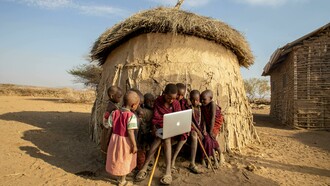Ildefons Cerdà i Sunyer, a 19th-century Spanish intellectual and engineer, is credited with having coined and put into practice the concept of urbanisation. Cerdà reasoned and developed a theory on the expansion and development of cities, in essence the science of “making cities,” and this became known as the *General Theory of Urbanisation. The theory focuses on the social, economic, and cultural impacts of cities on the lives of their inhabitants. Consequently, like migration, urbanisation is now widely regarded as an inevitable and inexorable global phenomenon.
In the late 1980s, South Africa witnessed major urbanisation trends largely influenced by internal migration from rural to urban areas due to the abolishment of the influx control laws. Urbanisation trends gave rise to the mushrooming of informal settlements near industrial hubs. The characteristic feature of most, if not all, of these informal settlements was and still is the lack of basic government services such as water, sanitation, electricity, road infrastructure, and amenities for leisure. In South Africa, urbanisation intensified in the 1990s following the dawn of democracy, when just over 50 percent of the population migrated to live in urban areas.
By 2022, more than 60% of the South African population was already living in urban areas, with this figure expected to rise to 70% by 2030 and 80% by 2050. The National Development Plan (NDP) estimates that by 2030, urbanisation will grow by a further 7.8 million people, with major metropolitan cities such as Johannesburg, Pretoria, and Cape Town absorbing a major share of this population. Cities generate about 85% of all economic activity in the country. The 2022 Census Report indicates that the Western Cape, Northern Cape, North West, Gauteng, and Mpumalanga provinces demonstrated a positive net migration, meaning that more people migrated into these provinces than they migrated out. The motivation for this inter-provincial migration is poverty and a lack of economic opportunities for employment and business growth.
Internationally, countries such as Zimbabwe (1,012,059), Mozambique (416,564), Lesotho (227,770), Malawi (198,807), and the United Kingdom (61,282) lead in the number of migrants who live and settle in urban areas in South Africa. Some of the migrants live in urban informal settlements, while others occupy dilapidated government properties. South Africa, as an active member of the international community, recognises the fact that growing urbanisation presents both economic opportunities and social challenges. On the economic front, urbanisation promotes government planning centred on integrating multi-sectoral strategies to address, among others, the large concentration of poverty in urban areas, unemployment, inequality, climate change, and environmental risks that benefit large sections of the population in urban areas. The NDP further acknowledges that the effects of urbanisation include growth in the wage-earning class (where jobs are available); higher demand for education, consumer goods, healthcare, and transport; a new business class of entrepreneurs and managers; and gains in output per worker.
The 2022 Census Report further highlights the point that ‘cities have the potential to be economically dynamic through the spatial concentration of productive activity, serving as markets for products produced in rural areas, competitive spaces for entrepreneurial innovations, sources of labour, accessible to consumers, and supporting institutions such as universities and financial and business services. It is also cheaper to provide municipal and other social services to highly concentrated populations than to more geographically dispersed populations'. Socially, urbanisation presents challenges such as increasing demand for social goods and services, for example, housing, municipal services, employment opportunities, and infrastructure.
In South Africa, “cities are struggling to keep up with the demand for housing and social and economic infrastructure for a growing population of poor households, many of which are in informal settlements. South Africa’s cities and large towns account for 80 percent of South Africa’s gross value added (GVA). It is for this reason that addressing urbanisation challenges requires government planning that puts urban development at the centre of its national strategies to ensure that urban settlements are liveable, adequate, sustainable, environmentally resilient, and efficient in supporting economic growth and social cohesion.
On October 20, 2016, the United Nations General Assembly adopted and endorsed the New Urban Agenda (NUA). The latter calls for a paradigm shift in the planning and development of cities in the twenty-first century and beyond. The paradigm shift entails, inter alia;
- Embracing urbanisation at all levels of human settlements,
- Crafting of appropriate policies that can take advantage of urbanisation across physical spaces,
- Bridging the development gulf between urban, peri-urban and rural areas,
- Assisting governments in addressing urbanisation challenges through national and local development policy frameworks,
- Integrating equity to the development agenda,
- Fostering national urban planning and planned city extensions,
- Accelerating the achievement of targets set out in the United Nations 2030 Sustainable Development Goals through sustainable urbanization; and
- Aligning and strengthening institutional arrangements.
The NUA states that the 21st century is the urban century, with 4.4 billion (56% of the global population) people living in urban areas. The urban population is expected to be more than double its current size (8.1 billion people) by 2050, with nearly 7 out of 10 people living in cities. ’Current urbanisation trends indicate that the expansion of urban land consumption outpaces population growth by as much as 50%, which is expected to add 1.2 million km2 of new urban built-up area to the world by 2030. Such sprawl puts pressure on land and natural resources, resulting in undesirable outcomes. Cities represent two-thirds of global energy consumption and account for more than 70% of greenhouse gas emissions.
To respond to the challenges of the conjoined twins of persistently rising migration patterns both domestically and internationally coupled with rapid urbanisation, South Africa has developed the Integrated Urban Development Framework and the District Development Model, which provide a common national vision and policy context that adheres to the national priorities set out in the NDP. The latter emphasises urban planning and the provision of adequate housing as well as liveable, safe, inclusive, and resilient human settlements. Strengthening the capacity of the state requires increased and sustainable support from development finance institutions, international partners, citizens, community organisations, cooperatives, the private construction sector, and banks; in other words, a whole-of-society approach.
International partnerships with organisations such as the United Nations Human Settlements Programme (UN-Habitat), the Cities Alliance, and others are aimed at not only building technical capacity for evidence-based policymaking but also mobilising additional resources to develop modern cities that cater for all sections of society, including vulnerable groups such as women, children, and persons living with disabilities. It must be highlighted that, despite the persistent challenges of urbanisation and human settlements in general, in "2022, South Africa registered a positive trend in households residing in formal dwellings, an increase of almost 24 percentage points from 65.1% in 1996 to 88.5%, according to the Census 2022 report.
Formal dwellings include formal houses with a brick or concrete structure, flats and apartments, cluster houses, townhouses, semi-detached houses, or any formal dwelling situated in a backyard, such as a room or garden cottage where a household or single person resides. The proportion of households that resided in informal dwellings halved from 16.2% in 1996 to 8.1% in 2022." Evidently, South Africa is on the right path, albeit not at a desired speed, to achieving the 2030 Sustainable Development Goal Tagert 11.1, which enjoins governments to guarantee access for all to adequate, safe, and affordable housing and basic services and upgrade informal settlements by the end of the current UN Decade of Action (2020–2021).
Notwithstanding the challenges of globalisation, whether demonstrated through incoming or outgoing migration or urbanisation trends, what used to be considered national interests is difficult to confine within national borders. International cooperation and partnerships are the only options open to all, given the rapid rate of international migration and urbanisation. In effect, people live in areas or countries where there are no opportunities for a better life than where they see them. Globalisation, whether one embraces or rejects it as an intellectual paradigm or practice, has undeniably created a world that is intertwined in multiple ways, e.g., on trade, information exchanges, and the internationalisation of domestic challenges such as urbanisation and migration. Cooperation, partnerships, and resource mobilisation have to be elevated above other international concerns insofar as human rights, human dignity, and a better life are concerned.
References
- Government of South Africa. (2012). National Development Plan 2030: Our Future - Make it Work.
- Statistics South Africa. (2022). Census 2022: Statistical Release.
- United Nations. (n.d.). The New Urban Agenda.
- World Bank. (n.d.). Urban Development.













